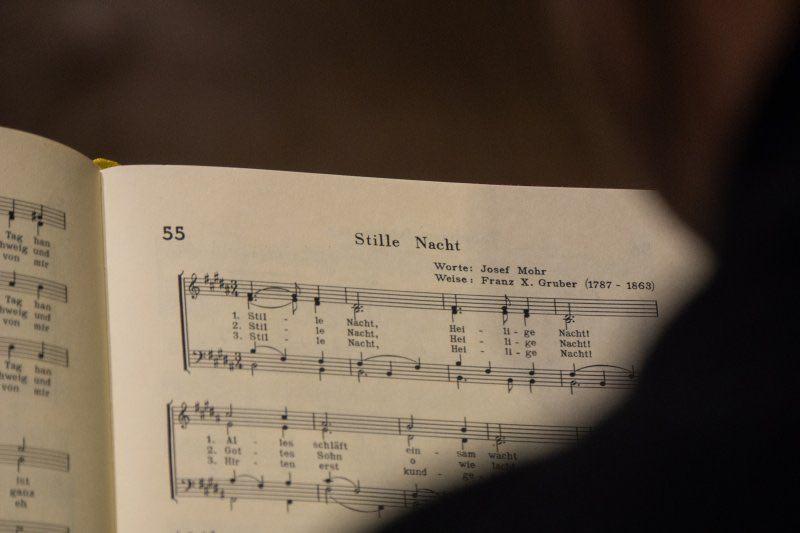Christmas in 2020 calls for more subdued celebrations to reflect on the preceding year and feel gratitude for what we have. The cello’s deep sound is perfect for bringing listeners to a somber and reflective place, and these carols were selected just to highlight the resonant beauty of the instrument.
These classic carols for cello will bring friends and family together to sing and reminisce, and the advice provided here will help you learn them in time for Christmas. All of the sheet music for these carols for cello can be found for free CelloOnline.com.
We Three Kings
Written by John Henry Hopkins Jr. in 1857, this was the first popular American Christmas carol using original music and lyrics. Earlier versions had three solos for male voices to represent the three magi in the legend. Like a singer, make long phrases out of the melody with dynamics and articulation. For example, on the repeated Gs in measures 17-32, use increasing bow speed to create a slight crescendo. Think of your bow as the singer’s breath, you must always be inhaling or exhaling with your up and down bows.
O Come, O Come Emmanuel
This carol requires long phrasing to express the pleading invocation of the ancient text, which dates back to monasteries in the 8th century. The melody was originally written in the 1500s for funerals, but was combined with the carol in 1851 and became famous. Similar to We Three Kings, use bow speed to crescendo on the repeated eighth notes in the first measure. The phrase should follow the contour of the melody Use large up bows on the quarter notes of measures 13-15, so you can maintain the dotted half notes.
What Child is This?
This traditional English melody known as Greensleeves was combined with original lyrics by William Chatterton Dix in 1865. The irregular rhythms under slurs mean you need strong left hand articulation to make the notes distinct. Make sure when you extend for the G#s to bring the thumb under the second finger, so the left hand weight is centered and the G# is a small half step from the A.
O Come, All Ye Faithful
Translated from the Latin Adeste Fideles, this carol’s melody uses the Mixolydian mode, meaning that it is written in G Major but its range is based on D. Make sure not to miss the second finger c natural in measure 10, playing in the Mixolydian mode might make muscle memory kick in and lead to an accidental third finger. As with the other carols, phrase according to the contour and rhythm of the melody with a sustained and resonant sound.
Silent Night
Do you need practice keeping your fingers down during string crossings? Silent Night is one of the best carols for cello on this list for helping with finger placement practice! In the first measure, keep fourth finger on the G when crossing to the A. Make sure to play with a smooth, connected sound throughout, but especially on open string eighth notes. Prepare the fourth finger D in measure 5 while playing E on the D string. In measure 17 use first finger, to prepare for the high f in the following measure.
Angels We Have Heard on High
One of the most memorable settings for Gloria, and my favorite Christmas carol on this list. This type of melody which uses many notes under one syllable (the “o” in “Gloria”) is called melismatic. Make smooth bow changes in order to keep the phrase continuous and closer to the singer’s style. As with We Three Kings, make a slight crescendo on the repeated notes at the beginning with increasing bow speed.
Prepare the fourth finger G while playing the open A eighth note in measure 4, and again in measure eight when this phrase is repeated. Use a second finger on the D in measures 9 and 15, shifting back on first finger for the B. This fingering minimizes the distance of the shift, since we can’t play all the notes in one position. The long phrase starting in measure 9 continues all the way to the open D in measure 12, which repeats in measures 15-18.
O Holy Night
Another carol from the mid-1800s, O Holy Night requires precise internal counting of the beats and delicate phrasing to bring the simple melody to life. The first phrase should have a crescendo leading into the dotted half note G in measure 3, and follow the contour of the melody until the repeat in measure 6. Subdivide the dotted quarter notes in measures 11 and 13 so you don’t rush. The phrase starting in measure 15 should build in energy until the B in measure 19, and then come gently back. Take plenty of time in measure 25 to make the final note special, which should be held for the full 4 beats.
Hopefully, these carols for cello will help light up your holiday season, and build your repertoire for years to come.
William Crider


